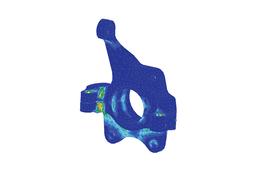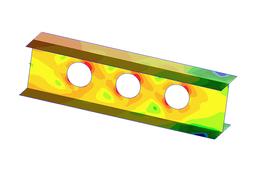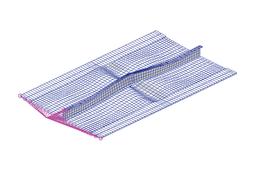
Multidiscipline Simulation Software Supplier, Linear and Nonlinear Finite Element Analysis (FEA), Control Systems Simulation and more
Our advanced motion analysis products enable engineers to easily simulate and test virtual prototypes of mechanical systems in a fraction of the time and cost required for physical build and test.
A multibody dynamic (MBD) system is one that consists of solid bodies, or links, that are connected to each other by joints that restrict their relative motion. The study of MBD is the analysis of how mechanism systems move under the influence of forces, also known as forward dynamics. A study of the inverse problem, i.e. what forces are necessary to make the mechanical system move in a specific manner is known as inverse dynamics.
Motion analysis is important because product design frequently requires an understanding of how multiple moving parts interact with each other and their environment. From automobiles and aircraft to washing machines and assembly lines - moving parts generate loads that are often difficult to predict. Complex mechanical assemblies present design challenges that require a dynamic system-level analysis to be met.
Accurate modeling can require representations of various types of components, like electronic controls systems and compliant parts and connections, as well as complicated physical phenomena like vibration, friction and noise. Motion analysis enables one to meet these challenges by quickly evaluating and improving designs for important characteristics like performance, safety and comfort. MSC solutions for motion analysis cover a broad range of multibody dynamics simulation functionality provided through rich, easy-to-use pre and post-processing interfaces and industry leading solvers.














MSC Software is used for many types of motion analysis:
- Rigid and flexible multibody systems
- Sensitivity analysis
- Vibration analysis
- Vehicle design & testing
- Coupled control/mechanical system analysis
- Kinematics and kinetics
- Contact and friction
- Loads and displacement
- Durability and life-cycle analysis
- Fracture or fatigue calculations
- Kinetic, static, and dissipative energy distribution
- Vehicular cornering, steering, quasi-static, and straight-line analysis
- Control system analysis
Industry Uses:
Aerospace & Defense: Aircraft engines, space vehicles, landing gears, helicopter fuselage, weapon systems, armaments, aircraft control mechanisms, ejection seats, flight simulators, battlefield vehicles, mission-critical spacecraft mechanisms.
Automotive: Suspension systems, Drivetrains, brake systems, steering systems, engines, control systems, transmissions, boot joints, bearings, clutches, chassis structure.
Manufacturing: robotic manipulators, conveyor belts, pumps, machine tools, packaging equipment, gears, stepper and server motors.
Heavy Equipment: excavators, agricultural equipment, hydraulic control systems, tracked vehicles, fork lifts, amusement park rides.
Medical: Orthopaedics, human locomotion, biodynamics, dynamometry, ergonomic analyses, robotic limbs.
Consumer Products: Sporting goods, bicycles, tools, printers.
Energy: Wind turbines, solar panels, offshore structures, drilling rigs, centralizer mechanisms.
CAD Integration

CAD-INTEGRATION OF JET FLAP AND LANDING GEAR VIA SIMDESIGNER
Import CAD neutral geometry formats including STEP, IGES, DXF, DWG or Parasolid.
Import native CAD geometry formats including CatiaV4, CatiaV5, Inventor, STEP, IGES, Acis, ProE, Creo, SolidWorks, Unigraphics, VDA.
Flexible Body Analysis

MODE SHAPE VISUALIZATION OF BUSINESS JET FLEXIBLE INNER FLAP

MODAL STRESS RECOVERY ON AN AUTOMATIC WEAPON FLEXIBLE CASING EJECTION
Adams provides technology to correctly include a component’s flexibility even in presence of large overall motion and complex interaction with other modeling elements.
Systems typically contain one or more structural components where deformation effects are paramount for design analyses and the rigid body assumption is no longer valid. Adams/Flex allows importing finite element models from most major FEA software packages and is fully integrated with Adams package providing access to convenient modeling and powerful post-processing capabilities.
The ViewFlex module in Adams/View enables users to transform a rigid part to an MNF-based flexible body using embedded finite element analysis where a meshing step and linear modes analysis will be performed. It is our new product module powered by MSC Nastran, allowing one to create flexible bodies without leaving Adams/View and without reliance on 3rd party Finite Element Analysis software. Also, it’s a streamlined process with much higher efficiency than the way users have traditionally generated flexible bodies for Adams in the past.
Multidiscipline Mechanical System Simulation

VIEWFLEX MODEL IN ADAMS/VIEW.
With functionalities like Adams2Nastran export and ViewFlex, Adams introduces bi-directional integration with MSC Nastran that allows re-use of validated Adams models to perform modal and frequency response analysis.
Adams/Mechatronics easily incorporates control systems into mechanical models by dynamically linking an external system library from a controls application, such as Easy 5 and MATLAB. Control system parameters can be quickly adjusted for evaluation and included in a design study for simultaneous optimization of both control system and mechanical system
Contact Modeling

FLEXIBLE-TO-FLEXIBLE AND FLEXIBLE-TO-RIGID BODY CONTACT

BALL SCREW MECHANISM FEATURING ANALYTICAL SPHERE CONTACT
An important part of many multibody systems is the contact that occur between the parts.
MSC’s motion analysis offerings provide a variety of contact modeling functionality. Rolling and sliding contacts and impact can be represented between rigid bodies, flexible and rigid bodies as well as between two flexible bodies.
Contact primitives provide a highly-efficient solution for simple geometry. More sophisticated methods are used for contact between complex geometries both rigid and flexible. In no case is a previous knowledge of "contact regions" required.
Durability Analysis

DURABILITY HOT SPOTS ON FLEXIBLE SUSPENSION FROM FULL VEHICLE

MODAL STRESS RECOVERY ON HOSPITAL BED LIFT
Durability issues discovered too late in the development cycle will cost you time and money. If they are not addressed before product launch they will lead to high warranty costs and low customer satisfaction. Durability testing is a critical aspect of product development. The ability to answer the question “Will it last?” can affect not only the design of a component, but the entire system. Good durability characteristics often conflict with other attributes, such as ride and handling or NVH, and finding a way to balance competing requirements is necessary. Accurately replicating durability tests is an important step on the path towards optimal design.
MSC solutions allow one to assess stress, strain, or life of components in your system model. By interfacing to fatigue programs life predictions and factor-of-safety analyses are possible. Model correlation and process streamlining is enabled through direct access to physical test data in industry-standard file formats. MSC’s products also allow one to extend the component mode synthesis capability used for flexible body integration and recover stresses on flexible bodies. Results from a motion solution are combined with modal stresses from FE to more accurately predict the stress in a flexible component. All stress or strain resulting from external forces or constraints and inertia effects can be recovered in the most efficient way.
Vibration Analysis

ALL-TERRAIN VEHICLE ON A 4-POST SHAKER
Perform system-level vibration analyses like frequency response studies and normal modes analysis. MSC solutions provide vibration-specific modeling elements like frequency dependant bushings and forcing functions for power spectral density, swept-sine and rotational imbalance. Coupled with vibration and frequency-domain specific post-processing, this leads to easy analysis and visualization of system modes, frequency response, modal participation tables, component energy distribution, etc.
Control System Integration

SATELLITE DISH WITH INTEGRATED ELECTRONIC CONTROL SYSTEM

INTEGRATED MECHANICAL SYSTEM WITH CONTROL SYSTEM ENGINEERING
MSC’s motion analysis offerings allow easy integration of the mechanical system and control system models
Many physical systems are a combination of mechanical components actuated by pneumatic, hydraulic or electrical subsystems that are controlled by electronic control units. System models need to fully account for actuation and control systems effects to correctly capture the behavior of the complete assembly. Typically, control systems are best represented by block diagrams with results viewed in plots and motion models are commonly represented by three dimensional geometry with output viewed in graphical animations as well as plots.
Incorporate mechanical models within block diagrams of the control system design software itself or directly import the actuators and/or controllers from the controls design software in the mechanical system simulation environment. Such interaction is supported with MATLAB/Simulink and EASY5 software.
DOE and Optimization Tools

RESPONSE SURFACE DIAGRAM

OVERLAY ANIMATION OF MULTIPLE DESIGN VARIANTS PERFORMING A LANE CHANGE MANUEVER
For simple design problems, one can explore and optimize the behavior of mechanical systems using a combination of intuition, trial-and-error, and brute force. However, as the number of design options increase, these methods become ineffective in formulating answers quickly and systematically. Varying just one factor at a time does not give you information about the interactions between factors, and trying many different factor combinations can require multiple simulations that leave you with a great deal of output data to evaluate.
To help remedy these time-consuming tasks, MSC provides planning and analysis tools for running a series of experiments that helps to determine relevant data to analyze, and which automates the entire experimental design process. This helps increase the reliability of your conclusions, get you answers faster than trial-and-error or testing factors one at a time, and help you better understand and refine the performance of your mechanical system.
Customization and Automation

TEMPLATE DRIVEN COMPONENT, SUBSYSTEM AND FULL VEHICLE MODELING

VEHICLE-SPECIFIC CUSTOMIZATION OF ADAMS/CAR
Time is saved and a broader user audience can be reached by tailoring the analysis environment for specific needs. MSC’s motion analysis solutions provide multiple means of automating the model construction, solving, and post-processing activities. Model construction can be automated by macros or templates. Custom interfaces can be created and incorporated directly into the “off-the-shelf” tool. And, powerful industry/application-specific packages are available from MSC and our business partners.
Related Products:
- Adams The Multibody Dynamics Simulation Solution
- Adams Car Real Dynamics for Vehicle Design and Testing
- Adams Machinery A Powerful Simulation Suite for Mechanical Drive Systems
- Adams MaxFlex
- Adams Real Time
- SimDesigner CAD-Embedded Multidiscipline Simulation
- SimXpert Fully Integrated Multidiscipline Simulation Solution


































